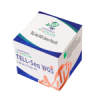A new publication in Current Protocols in Human Genetics offers a thorough description of library preparation steps for sequencing with Illumina instruments. “Improved Protocols for Illumina Sequencing” comes from senior author Harold Swerdlow at the Wellcome Trust Sanger Institute and colleagues.
The detailed steps provided in the publication will “make the sequencing process more reliable in a high-throughput environment, reduce amplification bias, narrow the distribution of insert sizes, and reliably obtain high yields of data,” the authors note. The protocols described come from years of optimization studies at Sanger and represent the standard sequencing pipeline now used at the institute.
As many of our customers with Illumina sequencers know, size selection is an important part of the sample prep process. “Cluster amplification is a relatively inefficient process,” the scientists write. “Larger fragments [above 500 bp] up to 1,000 bp will cluster, but with increasingly lower efficiency and lower yield.”
Swerdlow and his colleagues use a variety of size-selection tools; when they need very tight sizing or are concerned about the generation of chimeric templates from the PCR step, they rely on our technology to perform accurate sizing. “Where a very precise/narrow size distribution is necessary, we recommend using Sage Science’s Pippin Prep,” they write. This figure from the publication shows why:
The scientists note that even in cases where especially narrow sizing is not necessary, performing a second size selection step with Pippin after running PCR is important for reducing chimeras. “This additional size selection reduces the incidence of chimeras from ∼5% to 0.02%,” they report.







